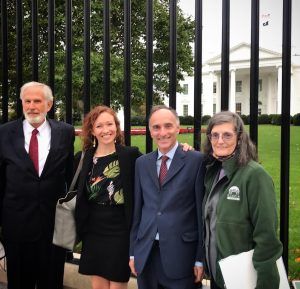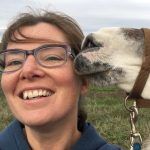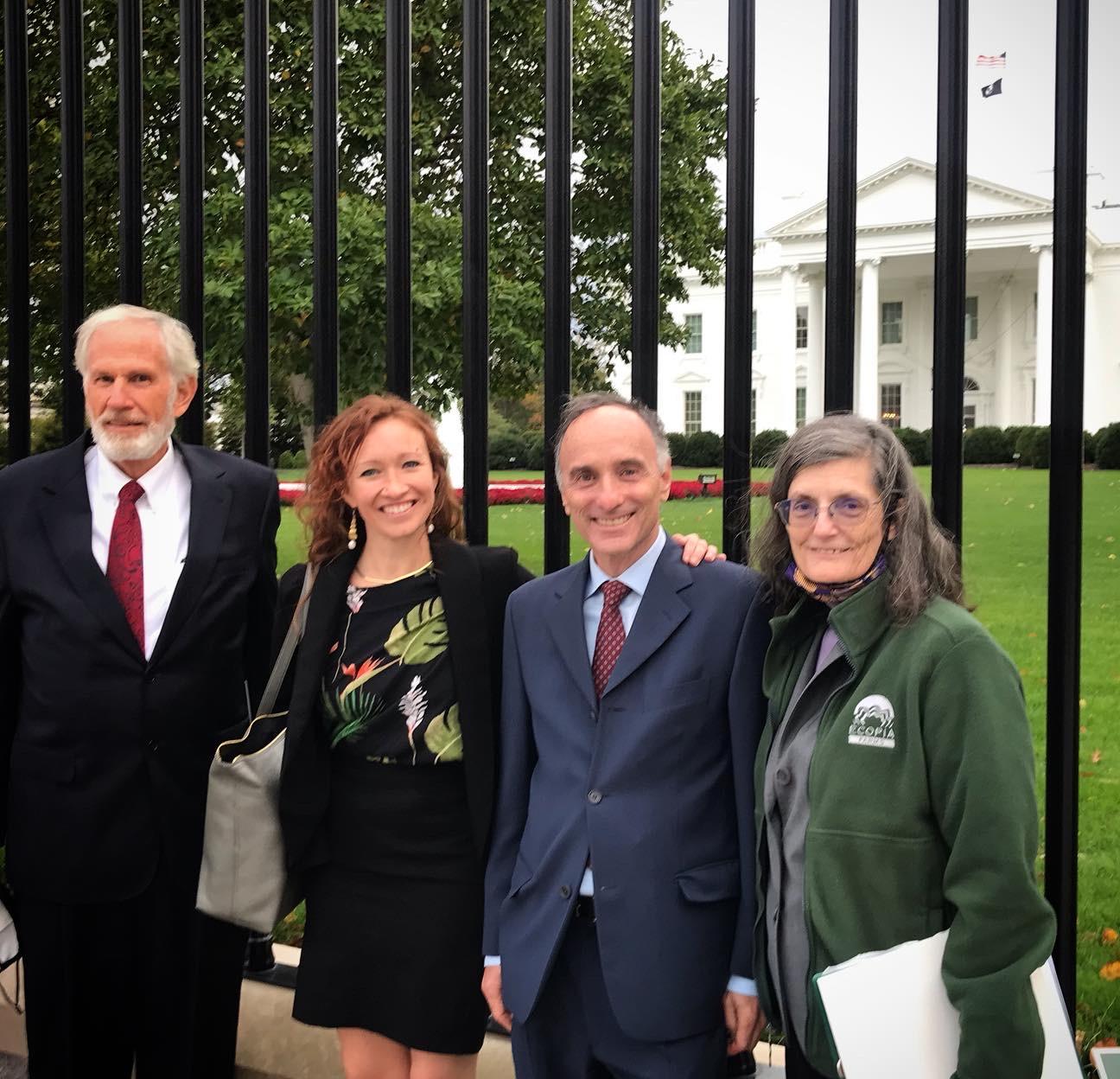
Dr. Elaine Ingham (right), travelled with Jeffrey Smith, Dr. Adrienne Godschalx, Dr. Tim LaSalle to Washington DC in October 2021 to raise Regenerative Agriculture Awareness.
Late in October, Dr. Elaine Ingham, founder of the Soil Food Web School, and Dr. Adrienne Godschalx, Soil Food Web School Mentor, travelled to Washington DC to raise awareness about Regenerative Agriculture and the importance of soil biology.
They joined Dr. Tim LaSalle, a farmer and co-founder of the Center for Regenerative Agriculture and Resilient Systems, and Jeffrey Smith, an advocate for protecting soil biology and founding executive director of The Institute for Responsible Technology.
Elaine, Adrienne, Tim, and Jeffrey met with a diverse mix of congressional staffers and also presented to an audience of ~2,000 (virtually and in person) at the National Press Club. (This presentation is available for replay here.)
The High Level Benefits of Regenerative Agriculture
Their goal for this trip was to lay the groundwork for deeper understanding about the benefits that Regenerative Agricultural practices can bring to farmers and to the planet as a whole. These benefits include:
- Restoring and perpetuating the health of living soils
- Enhancing environmental and economic resilience
- Making farming profitable and ecologically sustainable at all scales
- Achieving food security for communities and nations
- Combating climate change
- Preventing ecosystem collapse
- Protecting the world’s soils against erosion
- Providing healthier, toxin-free food for consumers
Breaking Down Soil Biology and Regenerative Agriculture Basics
The team covered a variety of focused topics with their audiences:
- Soil biology basics
- Regenerative Agricultural methods
- Farmer success stories
- Barriers to transitioning to sustainable methods
- Critical threats to soil health
- and more!
Policy Changes are the Long Term Goal
Their overall message was met with great interest and enthusiasm as well as invitations to meet with more groups. Given the success of this first joint foray inside the Capital Beltway, the team plans to return to DC again (and again?) to bring these topics to a wider audience. Can their input contribute ultimately to wide-ranging changes in agricultural and environmental policy? We hope so. Stay tuned!

Heather Boright
Heather lives on a 4-acre homestead in the Willamette Valley of Oregon with her husband and a bunch of leafy, feathered, furry, and wooly macroorganisms. (Plus, of course, countless microorganisms.) She has a BSc in Environmental Education from Western Washington University and loves learning and writing about the science of the natural world.





Super good, we need to raise awareness of regenerative agriculture all over the world. To spread chemicals on farming lands and in nature has never been a good idea and has no future. I hope they will get that in Washington DC that would be very good.
Thank you for this undertaking. I for one feel rather “helpless” , sort of a voice crying in the wilderness. I do try to make my voice heard, but never sure if anyone’s listening. It was good to hear your president reference Regenerative Ag practices at COP26.
We can only hope that there is brave politicians that see the light. No doubt there is going to be awareness of the meeting from the chemical industry.
Weeeheewwww!! So encouraging and exciting! Keep it up!! It’s a long road ahead but by no means an impossible one!! 🌞🌸
Superb presentation! Many congratulations! Putting the Soil Food Web on the map and giving, not just humanity, but most of the world’s flora and fauna a chance. 👏👏👏 And thank you, a thousand times over, for giving me the opportunity to do my bit.
Fabulous! Great News! So much Gratitude for your ongoing efforts to educate & to make a positive difference.
Great efforts, I don’t know how much this topik was overlooked at the recent COP26 Climate Change Conference here in the UK, but little about the great possibilities of rebuilding carbon in soils and reducing polluting practices in Agriculture has been reported during the event, instead there was simply an uneducated stab at Animal Agriculture in general to take the focus off the managerie of private jets used by many of the delegates who attended.
As a current student on Dr Elaine’s food web course and a land manager and grower/producer here in the uk where regenerative practices are now more and more in discusion amoungst the main stream farming community it is my ultimate aim to understand more the details and complexities of the natural system for both my own business and more so to preach for the benefits of UK growers and the wider community.
I was taught almost none of this at Agricultural College in the 1990’s and unfortunately it is still much so in the current Agricultural Education Syllabus. Our politicians are generally only here for five years or until the next government our farmers are here for a lifetime or generations of lifetimes if they can understand, change their thinking and succesfully adopt for their own economic and ethical reasons then we may see a revolution. In the subject of regenerative agriculture it is transition that is often considered the big stumbling block but here are the tools and knowledge to make this a more understood and straight forward process.
Dr Elaine and the team keep up the good work you are truly inspiring.
Love the efforts thank you!
The future looks brighter for All of Us! Beautiful! Thank you!
Thanks for the update and let me know if there is anything I can do!!
Great job! Congrats and thanks for your efforts on spreading the knowledge
Fantastic! We should lobby the Chesapeake Bay Foundation on the SFW! Here is why: Did you all know that Maryland gets $21 million a year to pay farmers to plant cover crops to reduce nutrient runoff into the Chesapeake Bay? Congress mandated the program after a massive fish kill. The biggest pollution source after they closed the steel mills is runoff from farms in the five major watersheds. The farmers taking the Maryland subsidy to plant cover crops have even started to go no-till – and are proud of their improvements – and resulting drop in runoff. However, if we could lobby the Chesapeake Bay Foundation to take a serious look at SFW farming – they could really move programs like this into high gear. One farmer in a promotional video was justifiably very happy with his conversion to no till and covers – And from a SFW perspective I could see immediately that A.) his dropped material was being attacked by black mold; B.) he had green tinted soil where it was likely puddling; and C.) his soil was only tan. These are big operations using conventional ag with cover crop no till. I want to show this big area farmer the SFW approach and conversion options/steps! Cheers for the lobbying – I will watch with interest!!!
Thank you for doing this!
Have a look at the Agricultural colleges and University agriculture faculties. Best results are with the young.
Fantastic efforts on the part of this team……. I’d offer to consider adding a scope of influence around Regenerative practice in the forms of depth and width ( bredth [sp]to the “high Level” , these being community resilience and local economic stability, educational experience at the level and value around complexity in applied knowledge, workforce development and education… both systemic, and on individual levels, let alone the impact in workforce preparation with respect to exposure and collective practice. We’re also potentially looking at the impacts around housing, community building, workforce mobility, transitions facilitation supporting retiring farm owners/workforce, agriculture and natural resource professionals…….. there is clearly a depth and bredth in scope to consider and value here as well. Then there is the longer view in overall health and quality of life that better nutrition and access to quality food materials would present and most definitely would add to the conversations…….. again, many thanks to this group of dedicated professionals.